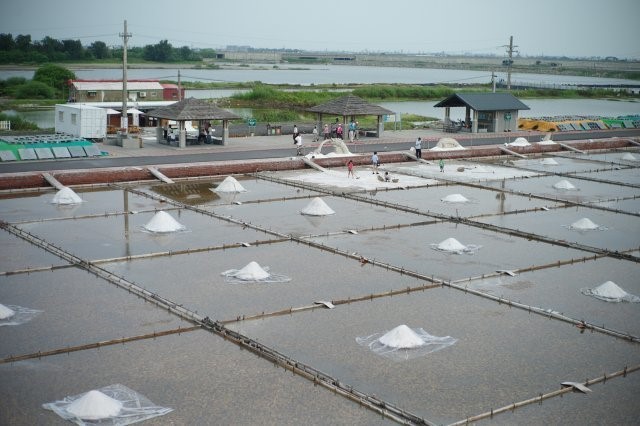View count:
3400
Landscape resources
 The landscape of the Geopark is dominated by estuarine wetland landforms and coastal processes with the popular landforms being sand dunes, sandbars, lagoons, river mouths, marshland, etc. Besides, human activities with traditional livelihoods also contribute to forming the diversity of landforms with various salt fields from north to south. In which, the mangrove is a typical form of wetland vegetation. At coastal wetlands, saltwater and freshwater mix together, so mangroves have evolved unique ways to survive in this brackish-water environment. Their thick leaves enable them to expel salt while storing water. The mangroves propagate viviparously and they have a system of roots comprised of supporting roots, underground roots, and breathing roots.
The landscape of the Geopark is dominated by estuarine wetland landforms and coastal processes with the popular landforms being sand dunes, sandbars, lagoons, river mouths, marshland, etc. Besides, human activities with traditional livelihoods also contribute to forming the diversity of landforms with various salt fields from north to south. In which, the mangrove is a typical form of wetland vegetation. At coastal wetlands, saltwater and freshwater mix together, so mangroves have evolved unique ways to survive in this brackish-water environment. Their thick leaves enable them to expel salt while storing water. The mangroves propagate viviparously and they have a system of roots comprised of supporting roots, underground roots, and breathing roots.Interwoven with the coastal mangrove system is the lagoon system, in which Cigu lagoon is really a unique landscape. Healthy and diversified ecosystems are the most valuable asset of Cigu Lagoon; however, the combination of fishery, evident in the preponderance of seines and oyster racks, and thriving coastal ecosystems inhabited by diverse animal and plant species really makes Cigu Lagoon become unique. Looking out from the Seascape Pavilion near the lagoon, visitors can take in views of sandbars, lagoons, and salt pans in the enchanting sunset. Rich mangrove ecosystems and numerous species of fish, shrimp, mussels, oysters, and crabs, including bivalve molluscs like the Chinese Venus, are found in the estuary, which is filled with predominantly brackish water.
Bird watching is an indispensable activity in wetland regions; however, Cigu is much famous with many special birds. Among them, the black-faced spoonbills that fly in every year to winter at Cigu are the superstars of the Southwest Coast National Scenic Area. In the world, there are only about 1700 of them left, and according to a survey by Taiwan’s Wild Bird Society in January 2003, there are more than 700 of them passed the winter in the Zengwen estuary wetlands. Because the natural environment of the wetland has been improved, more black-faced spoonbills land down this wetland annually. They attract countless bird watchers both from Taiwan and overseas. Besides, in spring and summer each year, flocks of little egrets, cattle nests and black-crowded night herons gather and build nest in the windbreaks and mangrove forests, creating awesome scenes of “egret forests”. Great flocks of these birds return to nest at dusk. With their fluttering wings covering the skies, they form an unforgettable sight.
Walking along mud beaches, we can frequently see many tideland crabs and mud skippers. With their large numbers and approachability, along with their unique form and method of motion, they have become star objects in wetlands ecology observation-especially for children. Four types of crabs are abundant here. The males wave their huge single-side claws in their most characteristic action. Clusters of monk crabs and mud-skipper fish, with their unique jumping motion, provide yet unforgettable ecological sights.
The area had splendid salt fields since 1784, which contributed to its fame in literature and ways of life. In which, the Jingzaijiao Tile-paved Salt Fields are the first salt field in Tainan’s Beimen area and they are also the oldest relics of tile-paved salt fields that still exist in the country. Culturally and socially, it was part of historical rural affluence. Due to the competition from modern salt manufacturers, the fields were closed in 2001. However, these salt fields have been still preserved and turned into coastal nostalgia. Nowadays, they become the most special tourist salt fields in the Southwest Coast National Scenic Area. At Jingzaijiao, tourists can make their own solar salt using the ancient method, carrying salt with a shoulder pole and harvesting the salt. A tour guide service is available throughout the family-friendly salt-making trip. The salt fields also explain why the area is good for bird sanctuaries. Because the shallow salt fields along with the wetlands and swamps had a rich benthos, they provided migrant, seasonal and resident birds with safe nests and feeding. Some salt fields with deeper water became good places for harvesting small fish and krill (Lin & Su, 2019).

[1] Lin, J. C., Su, S. C. (2019). Geoparks of Taiwan. Their development and Prospects for a Sustainable Future











